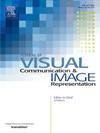Semantic-aware representations for unsupervised Camouflaged Object Detection
IF 2.6
4区 计算机科学
Q2 COMPUTER SCIENCE, INFORMATION SYSTEMS
Journal of Visual Communication and Image Representation
Pub Date : 2024-12-09
DOI:10.1016/j.jvcir.2024.104366
引用次数: 0
Abstract
Unsupervised image segmentation algorithms face challenges due to the lack of human annotations. They typically employ representations derived from self-supervised models to generate pseudo-labels for supervising model training. Using this strategy, the model’s performance largely depends on the quality of the generated pseudo-labels. In this study, we design an unsupervised framework to perform COD (Camouflaged Object Detection) without the need for generating pseudo-labels. Specifically, we utilize semantic-aware representations, trained in a self-supervised manner on large-scale unlabeled datasets, to guide the training process. These representations not only capturing rich contextual semantic information but also assist in refining the blurred boundaries of camouflaged objects. Furthermore, we design a framework that integrates these semantic-aware representations with task-specific features, enabling the model to perform the UCOD (Unsupervised Camouflaged Object Detection) task with enhanced contextual understanding. Moreover, we introduce an innovative multi-scale token loss function, which maintain the structural integrity of objects at various scales in the model’s predictions through mutual supervision between different features and scales. Extensive experimental validation demonstrates that our model significantly enhances the performance of UCOD, closely approaching the capabilities of state-of-the-art weakly-supervised COD models.
无监督伪装对象检测的语义感知表示
由于缺乏人工注释,无监督图像分割算法面临挑战。他们通常使用来自自监督模型的表示来生成伪标签来监督模型训练。使用这种策略,模型的性能在很大程度上取决于生成的伪标签的质量。在本研究中,我们设计了一个无监督框架来执行COD(伪装对象检测),而无需生成伪标签。具体来说,我们利用语义感知表示,在大规模未标记数据集上以自我监督的方式训练,来指导训练过程。这些表征不仅捕获了丰富的上下文语义信息,而且有助于精炼伪装对象的模糊边界。此外,我们设计了一个框架,将这些语义感知表示与特定于任务的特征集成在一起,使模型能够在增强上下文理解的情况下执行UCOD(无监督伪装对象检测)任务。此外,我们引入了一种创新的多尺度令牌损失函数,该函数通过不同特征和尺度之间的相互监督,在模型的预测中保持了不同尺度下目标的结构完整性。大量的实验验证表明,我们的模型显著提高了UCOD的性能,接近最先进的弱监督COD模型的能力。
本文章由计算机程序翻译,如有差异,请以英文原文为准。
求助全文
约1分钟内获得全文
求助全文
来源期刊

Journal of Visual Communication and Image Representation
工程技术-计算机:软件工程
CiteScore
5.40
自引率
11.50%
发文量
188
审稿时长
9.9 months
期刊介绍:
The Journal of Visual Communication and Image Representation publishes papers on state-of-the-art visual communication and image representation, with emphasis on novel technologies and theoretical work in this multidisciplinary area of pure and applied research. The field of visual communication and image representation is considered in its broadest sense and covers both digital and analog aspects as well as processing and communication in biological visual systems.
 求助内容:
求助内容: 应助结果提醒方式:
应助结果提醒方式:


